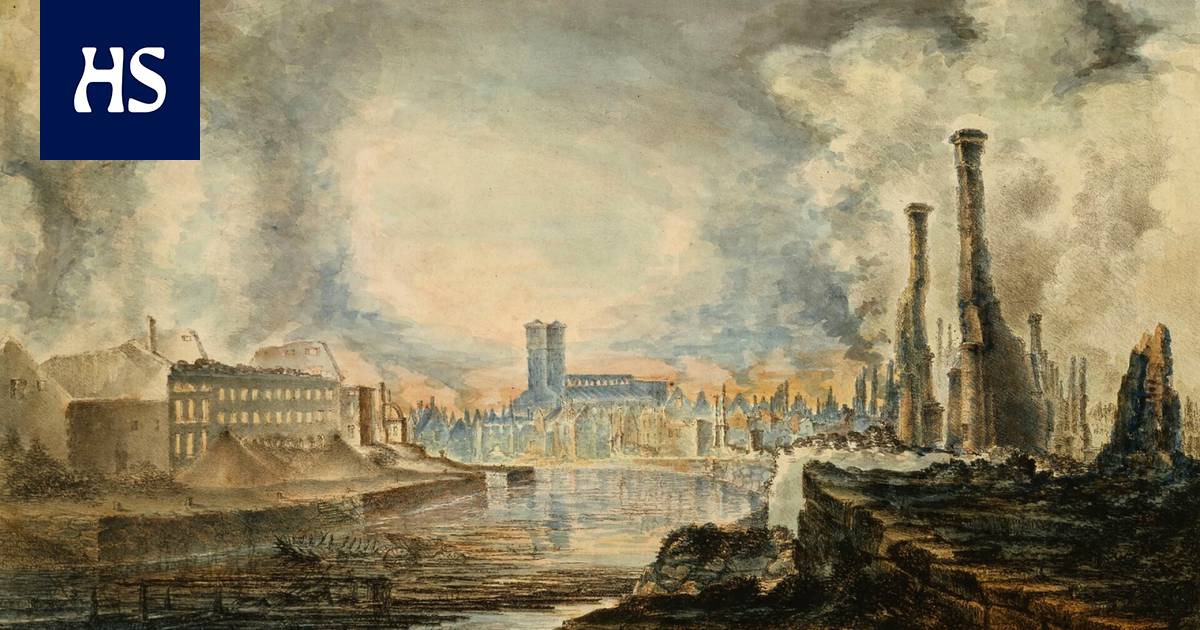In November in 1819 threatening placards appeared in various parts of Turku promising the city would be completely destroyed.
“Unfortunate citizens of Turku, take care, because before long your city will be in ashes,” the message threatened.
The person calling himself the avenger even attached the note to the Cathedral, to the door of the judgment hall. In it, he promised that the church would fly into the air before long.
The notes left by the avenger were forgotten before long, and the identity of their writer was never revealed.
The person who wrote in Swedish also used Latin in his messages, so Kostaja was probably a representative of the educated class who went to school.
Avenger the threats came true eight years later. On Tuesday, September 4, 1827, a fire broke out in the city. It reached a huge sea of fire, which swallowed even the tower of the Cathedral.
In the largest accident in the Nordic countries, three quarters of the city’s building stock was destroyed. 14,000 people lived in the city, of which 11,000 were left without a home.
Professor of Cultural History Hannu Salmi tells, among other things, about Kostaja in his book to be published on Thursday The fire of emotions – Turku in flames 1827.
Hannu Salmi
“The threatening notes were probably related to the conflicts between the students and the authorities, and nothing connected them to the fire. The threat notes were an interesting coincidence,” Salmi emphasizes.
The Turku fire was an international news event that was reported as far as Australia. The testimony of the French newspaper Le Figaro compared the destruction of Turku to the biblical destruction of Sodom and Gomorrah. In Finland, it was not understood how widely the information about the destruction spread.
“The fire was the first Finnish media disaster.”
Aninkaistenmäki wooden buildings that survived the fire in the 1880s.
The fire in Turku has been written about before. The most famous work is by Svante Dahlström dissertation from 1929.
“Fire is written from the point of view of urban fires and fire fighting and building history, and not so much from the point of view of people,” says Salmi.
Salmi wanted to deal with the destruction from an emotional perspective. What kind of feelings, sadness, guilt, greed and compassion did the events cause in the townspeople?
Salmi’s source material has been letters, diaries, memoirs, maps, pictures and newspapers. He followed the life stages of the people who experienced the fire with the help of scriptures and spirit books.
Book follows the events through several protagonists. Witnesses to the fire are: Christina Hellman and her maid Maria Vasswhich was considered the cause of the fire.
Other key people are a cathedral school student, 14 years old Adolf Moberg and the doctor Immanuel Ilmoni. Through them, the reader gets to know the progress of the sea of fire, the desperate attempts to put it out, and the start of reconstruction.
Conveying the events of the day of the accident through people takes the reader inside the events. The structure reminds me of the structure of disaster movies with human destinies.
The buildings destroyed in the fire in Turku were located on the plots marked in gray.
Before fire Turku was an idyllic place with plenty of wooden buildings built side by side. The town’s importance as a trading center is indicated by the fact that about 3,000 of the townspeople were burghers.
Turku of 1827 can be explored in the city of Turku in the digital museum.
In addition to being a trading post, the city was the center of academic life, including the university Elias lönnrot, Johan Ludvig Runeberg and Johan Vilhelm Snellman were logged in.
The city was calmer than usual on a Tuesday evening in September, because a large number of townspeople had gone to Tampere for the market.
Dealer Hellman’s wife Christina Hellman returned to town in the early evening. The family owned three plots of land at the top of Aninkaistenmäki.
A fireman putting out the Turku fire depicted in an oil painting by Robert Wilhelm Ekman.
A little before nine, Hellman smelled something burnt. He hurried outside and noticed dark smoke rising from the roof of the barn. Hay was stored there for the winter. The fire from the barn spread to the stable, shed and baking room.
Extinguishing the fire was practically impossible, although there were water barrels in the yards and warehouses in case of fires. Due to the summer with little rain, the buildings were dry, and a large part of the roofs of the Aninkaistenmäki buildings were made of thatch and peat.
Similar fires had broken out at the beginning of the 19th century in several localities. In addition to Turku, Raahe, Hamina, Oulu and Hämeenlinna were destroyed in the fires. Even in Turku, the fire was only a matter of time, but on a September evening, everything possible went wrong.
Yet At nine in the evening the air was windless, and a large fire hydrant could be brought to Aninkaistenmäki in half an hour. It was believed that the river would stop the fire’s movements, but within a couple of hours the north-west wind increased to gale force and pushed the flames towards Aurajoki.
14-year-old Adolf Moberg lived in Ryssänmäki (now Yliopistonmäki) and followed the progress of the fire. The entire Aninkaistenmäki was a sea of fire.
“The sight was horrifying but fascinating,” wrote Moberg later.
The city’s fire department was on Aninkaistenmäki, so the valuable buildings on the other side, i.e. the side of old Turku, were without protection.
The worst happened at midnight. The storm wind blew all kinds of burning material over the river. Point one, value building, professor Hällström house, was on fire next to the Cathedral.
Moberg described how the wind threw sparks and embers to the heights and fiery rain fell on the roof of the Cathedral. The fire gradually rose higher until the church tower rose from the sea of flames like a pillar of fire.
Firestorm next threatened Akatemiatalo, which had only been completed a good ten years earlier. The shutters of the academy building’s library had been left open, so the fire avalanche freely entered the building. The building was severely damaged, and Henrik Gabriel Porthanin the book collection he once cherished, 40,000 volumes, was destroyed.
The loss was so great that the librarian Fredrik Wilhelm Pipping lost his ability to work for several months.
The Strait ranks the destruction of the treasures of the Academy and the Cathedral as the biggest losses.
“Of course, the contemporary commentators of the fire were civilized people themselves, so the importance of book culture was particularly important to them. It’s no wonder that the destruction of the Academy building was compared to the ancient fire of the Library of Alexandria”.
The townspeople try to carry property from the buildings to the outskirts of the city. Many firefighters went to save their own property. Doctor Immanuel Ilmoni described how some rushed to the thieves.
Heroic deeds were also done during the night. Notary Gustaf Stålhandske saved the foreclosure archive at the same time as his own home was destroyed. Docent Gabriel Rein and high school student Mathias Akiander saved a large part of the Academy’s archives when the house was already burning.
Cathedral the clocks struck for the last time at three in the morning. After that, the clocks and machinery collapsed through the tower.
The fire advanced to Ryssänmäki and stopped just before the archbishop’s house. The fire was brought under control only on Wednesday afternoon.
The destruction was enormous: around 2,500 destroyed buildings and at least 17 dead.
Reconstruction started quickly after the destruction. From a German architect From Carl Ludwig Engel a site plan was ordered, in which the city was spread over a much larger area than before. Engel had designed the Helsinki Senate Square and its buildings.
In a more fire-safe city, the streets would become wider and the blocks smaller.
CW Gyldén’s city map from 1837 shows the town plan designed by Engel.
An accident the reasons began to be determined quickly, and the first court session was organized a couple of weeks after the accident. Even then, a rumor had spread about the servicemen’s careless use of fire.
Rumor has it that tallow was cooked in Hellman’s house, which then caught fire, and tar was stored on the property, which would explain the rapid spread of the fire.
“Rumors spread in the newspapers, where many talked about the carelessness of the service people,” says Salmi.
It turned out in court that the cause of the fire was a pure accident. A spark from a nearby house flew onto the roof of Hellman’s barn.
The sea of flames from the Turku fire did not reach Luostarinmäki. Today, there is a craftsman’s museum.
The court’s decision did not cut the wings of the rumor, but the false information smouldered for a hundred years. The main culprit for the misinformation was the writer Zachris Topeliuswhose lyrics named a young ignorant maid as the house arsonist.
“Topelius was a skilled dramatist who emphasized the individual and the importance of the individual in his own description,” says Salmi.
It wasn’t until the middle of the 20th century that the maid Maria Vass got her honor restored. The culprit of the fire in Turku was not the avenger who left threatening notes or the maid who cooked tallow, but the city was destroyed in a night of unfortunate coincidences.
Hannu Salmi: The fire of emotions – Turku in flames 1827 (Otava, 2022)
#Turku #September #evening #years #wrong #sea #sparks #started #spark #destroyed #Finlands #valuable #buildings




/s3/static.nrc.nl/wp-content/uploads/2024/04/23150213/data114524521-66da65.jpg)



